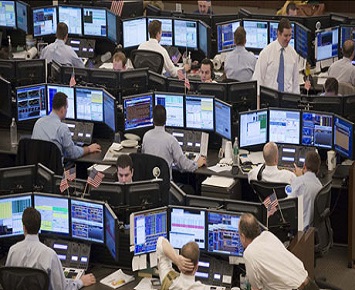Live in USA
 |
Electronic trading, sometimes called etrading, is a method of trading
securities (such as stocks, and bonds), foreign exchange or financial
derivatives electronically.1 Information technology is used to bring together
buyers and sellers through an electronic trading platform and network to create
virtual market places such as NASDAQ, NYSE Arca and Globex which are also known
as electronic communication networks (ECNs).
Electronic trading is in
contrast to older floor trading and phone trading and has a number of
advantages, but glitches and cancelled trades do still occur.
For many years
stock markets were physical locations where buyers and sellers met and
negotiated. Exchange trading would typically happen on the floor of an exchange,
where traders in brightly colored jackets (to identify which firm they worked
for) would shout and gesticulate at one another ¨C a process known as open outcry
or pit trading (the exchange floors were often pit-shaped ¨C circular, sloping
downwards to the centre, so that the traders could see one another). With the
improvement in communications technology in the late 20th century, the need for
a physical location became less important and traders started to transact from
remote locations in what became known as electronic trading.3 Electronic trading
made transactions easier to complete, monitor, clear, and settle and this helped
spur on its development.
One of the earliest examples of widespread
electronic trading was on Globex, the CME Group¡¯s electronic trading platform
conceived in 1987 and launched fully in 1992.4 This allowed access to a variety
of financial markets such as treasuries, foreign exchange and commodities. The
Chicago Board of Trade (CBOT) produced a rival system that was based on Oak
Trading Systems¡¯ Oak platform branded ¡®E Open Outcry,¡¯ an electronic trading
platform that allowed for trading to take place alongside that took place in the
CBOT pits.
Set up in 1971, NASDAQ was the world's first electronic stock
market, though it originally operated as an electronic bulletin boardcitation
needed, rather than offering straight-through processing (STP).
By 2011
investment firms on both the buy side and sell side were increasing their
spending on technology for electronic trading.5 With the result that many floor
traders and brokers were removed from the trading process. Traders also
increasingly started to rely on algorithms to analyze market conditions and then
execute their orders automatically.6
The move to electronic trading compared
to floor trading continued to increase with many of the major exchanges around
the world moving from floor trading to completely electronic trading.7
While
the majority of retail trading in the United States happens over the Internet,
retail trading volumes are dwarfed by institutional, inter-dealer and exchange
trading. However, in developing economies, especially in Asia, retail trading
constitutes a significant portion of overall trading volume.citation needed
For instruments which are not exchange-traded (e.g. US treasury bonds), the
inter-dealer market substitutes for the exchange. This is where dealers trade
directly with one another or through inter-dealer brokers (i.e. companies like
GFI Group and BGC Partners. They acted as middle-men between dealers such as
investment banks). This type of trading traditionally took place over the phone
but brokers moved to offering electronic trading services instead.
Download